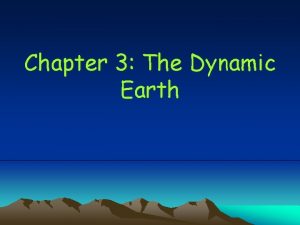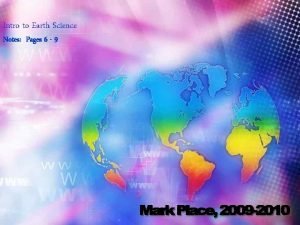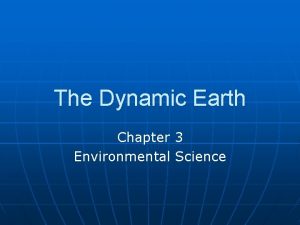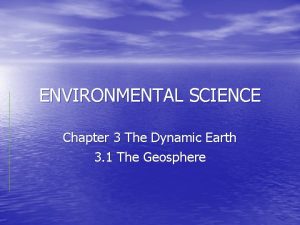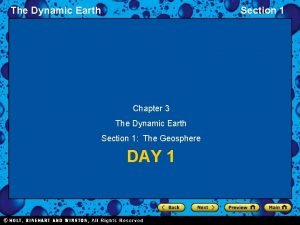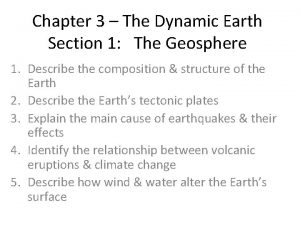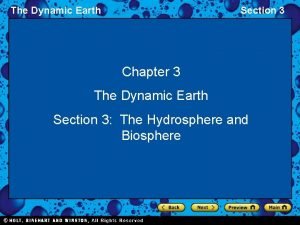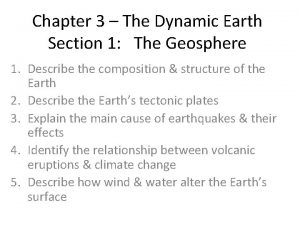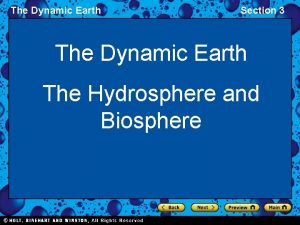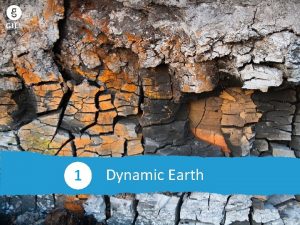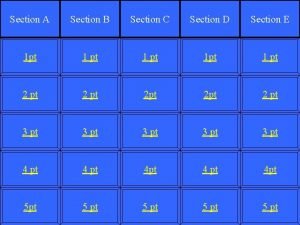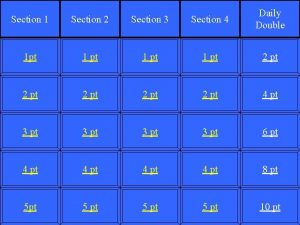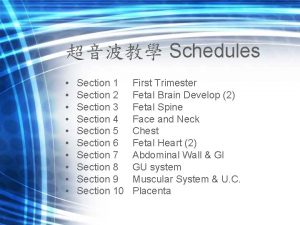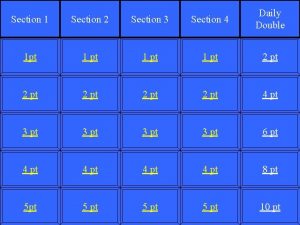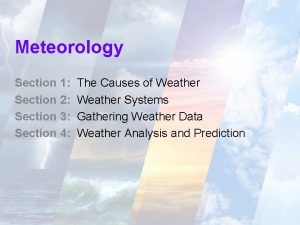The Dynamic Earth Section 2 The Dynamic Earth

























- Slides: 25

The Dynamic Earth Section 2 The Dynamic Earth The Atmosphere

The Dynamic Earth Section 2 The Atmosphere • The atmosphere is a mixture of gases that surrounds a planet, such as Earth. • Nitrogen, oxygen, carbon dioxide, and other gases are all parts of this mixture. • Gases can be added to and removed from the atmosphere through living organisms. • For example, animals remove oxygen when they breathe in and add carbon dioxide when they breathe out.

The Dynamic Earth Section 2 The Atmosphere • Volcanic eruptions also add gases to the atmosphere, while vehicles both add and remove gases. • The atmosphere also insulates Earth’s surface. • This insulation slows the rate at which the Earth’s surface loses heat and keeps Earth temperature at which living things can survive.

The Dynamic Earth Section 2 You. Tube Volcanoes Erupting

The Dynamic Earth Composition of the Atmosphere • Nitrogen makes up 78 percent of the Earth’s atmosphere, and enters the atmosphere when volcanoes erupt and when dead plants and animals decay. • Oxygen is the second most abundant gas in the atmosphere and is primarily produced by plants. • In addition to gases, the atmosphere contains many types of tiny, solid particles, or atmospheric dust. Section 2

The Dynamic Earth Section 2 Composition of the Atmosphere • In addition to nitrogen and oxygen, other gases such as argon, carbon dioxide, methane, and water vapor make up the rest of the atmosphere.

The Dynamic Earth Section 2 Air Pressure • Earth’s atmosphere is pulled toward Earth’s surface by gravity and as a result, the atmosphere is denser near the Earth’s surface. • Almost the entire mass of Earth’s atmospheric gases is located within 30 km of the surface. • Air also becomes less dense with elevation, so breathing at higher elevations is more difficult.

The Dynamic Earth Layers of the Atmosphere • The atmosphere is divided into four layers based on temperature changes that occur at different distances above the Earth’s surface. • The Troposphere • The Stratosphere • The Mesosphere • Thermosphere Section 2

The Dynamic Earth Layers of the Atmosphere Section 2

The Dynamic Earth Section 2 The Troposphere • The troposphere is the lowest layer of the atmosphere in which temperature drops at a constant rate as altitude increases. • This is the part of the atmosphere weather conditions exist. • The troposphere is Earth’s densest atmospheric layer and extends to 18 km above Earth’s surface.

The Dynamic Earth Section 2 The Stratosphere • The stratosphere is the layer of the atmosphere that lies immediately above the troposphere and extends from about 10 to 50 km above the Earth’s surface. • Temperature rises as altitude increases because ozone in the stratosphere absorbs the sun’s ultraviolet (UV) energy and warms the air.

The Dynamic Earth Section 2 The Stratosphere • Ozone is a gas molecule that is made up of three oxygen atoms. • Almost all of the ozone in the atmosphere is concentrated in the stratosphere. • Because ozone absorbs UV radiation, it reduces the amount of UV radiation that reaches the Earth. • UV radiation that does reach Earth can damage living cells.

The Dynamic Earth Section 2 The Mesosphere • The layer above the stratosphere is the mesosphere. • This layer extends to an altitude of about 80 km. • This is the coldest layer of the atmosphere where temperatures have been measured as low as – 93ºC.

The Dynamic Earth Thermosphere • The atmospheric layer located farthest from Earth’s surface is thermosphere. • Here, nitrogen and oxygen absorb solar radiation resulting in temperatures measuring above 2, 000 ºC. • The air in thermosphere is so thin that air particles rarely collide, so little heat is transferred, and would therefore not feel hot to us. Section 2

The Dynamic Earth Thermosphere • The absorption of x-rays and gamma rays by nitrogen and oxygen causes atoms to become electrically charged. • Electrically charged atoms are called ions, and the lower thermosphere is called the ionosphere. • Ions can radiate energy as light, and these lights often glow in spectacular colors in the night skies near the Earth’s North and South Poles. Section 2

The Dynamic Earth Section 2 Energy Transfer in the Atmosphere • Radiation is the energy that is transferred as electromagnetic waves, such as visible light and infrared waves. • Conduction is the transfer of energy as heat through a material. • Convection is the movement of matter due to differences in density that are caused by temperature variations an can result in the transfer of energy as heat.

The Dynamic Earth Section 2 You. Tube Atmosphere Song

The Dynamic Earth Section 2 Energy Transfer in the Atmosphere

The Dynamic Earth Section 2 Heating of the Atmosphere • Solar energy reaches the Earth as electromagnetic radiation, which includes visible light, infrared radiation, and ultraviolet light. • About half of the solar energy that enters the atmosphere passes through it and reaches the Earth’s surface, while the rest of the energy is absorbed or reflected in the atmosphere by clouds, gases, and dust or it is reflected by Earth’s surface.

The Dynamic Earth Section 2 Heating of the Atmosphere • The Earth does not continue to get warmer because the oceans and the land radiate the absorbed energy back into the atmosphere. • Dark-colored objects absorb more solar radiation that light-colored objects, so dark colored objects have more energy to release as heat. • This is one reason the temperature in cities is higher that the temperature in the surrounding countryside.

The Dynamic Earth Section 2 The Movement of Energy in the Atmosphere • As a current of air, warmed by the Earth’s surface, rises into the atmosphere, it begins to cool, and eventually become denser than the air around it and sinks. • This current then moves back toward the Earth until heated and less dense and then begins to rise again. • The continual process of warm air rising and cool air sinking and moving air in a circular motion is called a convection current.

The Dynamic Earth The Greenhouse Effect • The greenhouse effect is the warming of the surface and lower atmosphere of Earth that occurs when carbon dioxide, water vapor, and other gases in the air absorb and reradiate infrared radiation. • Without the greenhouse effect, the Earth would be too cold for life to exist. Section 2

The Dynamic Earth The Greenhouse Effect Section 2

The Dynamic Earth Section 2 You. Tube The Greenhouse Effect

The Dynamic Earth Section 2 The Greenhouse Effect • The gases in the atmosphere that trap and radiate heat are called greenhouse gases. • The most abundant greenhouse gases are water vapor, carbon dioxide, methane, and nitrous oxide, although none exists in high concentrations. • The quantities of carbon dioxide and methane in the atmosphere vary considerably because of natural and industrial processes.
 Chapter 3 the dynamic earth section 1 the geosphere
Chapter 3 the dynamic earth section 1 the geosphere Transferered
Transferered Earth's dynamic crust and interior topic 12
Earth's dynamic crust and interior topic 12 Dynamic equilibrium earth science
Dynamic equilibrium earth science Chapter 3 the dynamic earth
Chapter 3 the dynamic earth Chapter 3 the dynamic earth
Chapter 3 the dynamic earth Dynamic earth structure
Dynamic earth structure The dynamic earth chapter 3
The dynamic earth chapter 3 Chapter 3 the dynamic earth
Chapter 3 the dynamic earth The dynamic earth chapter 3
The dynamic earth chapter 3 Hình ảnh bộ gõ cơ thể búng tay
Hình ảnh bộ gõ cơ thể búng tay Lp html
Lp html Bổ thể
Bổ thể Tỉ lệ cơ thể trẻ em
Tỉ lệ cơ thể trẻ em Voi kéo gỗ như thế nào
Voi kéo gỗ như thế nào Tư thế worms-breton
Tư thế worms-breton Bài hát chúa yêu trần thế alleluia
Bài hát chúa yêu trần thế alleluia Kể tên các môn thể thao
Kể tên các môn thể thao Thế nào là hệ số cao nhất
Thế nào là hệ số cao nhất Các châu lục và đại dương trên thế giới
Các châu lục và đại dương trên thế giới Công của trọng lực
Công của trọng lực Trời xanh đây là của chúng ta thể thơ
Trời xanh đây là của chúng ta thể thơ Mật thư anh em như thể tay chân
Mật thư anh em như thể tay chân Phép trừ bù
Phép trừ bù độ dài liên kết
độ dài liên kết Các châu lục và đại dương trên thế giới
Các châu lục và đại dương trên thế giới
